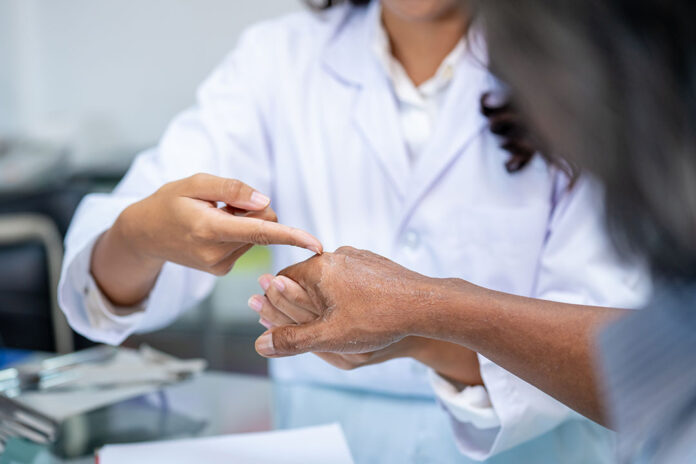Plaque psoriasis is a chronic, systemic inflammatory condition that impacts millions of people. Plaque psoriasis is the most common form of psoriasis, accounting for at least 80% of cases. It occurs as a result of an overactive immune system attacking healthy skin cells which leads to an overproduction of cells and ultimately plaques. This condition is associated with several other health conditions, so early treatment proper management is important to lower this risk.
This lifelong condition is characterized by the presentation of itchy plaques on the skin’s surface. Psoriasis can be classified as mild, moderate, and severe disease.The majority of cases are classified as mild to moderate. Plaques can appear anywhere on the skin but appear most commonly on the abdomen and midsection, scalp, hands, feet, elbows, and knees. Plaques are patches of skin covered in white or silver colored scales that vary in size and are round in shape. The peak ages of onset are between 20-30 years of age and 50-60 years of age. Men and women are affected equally. Psoriasis is not contagious.
While psoriasis is less prevalent in African Americans than Caucasians, it is underdiagnosed in African Americans and people of color. This may be because psoriasis is easier to identify on lighter skin tones. Patients with psoriasis have a higher risk of developing heart disease and risk factors such as diabetes, obesity, high cholesterol, and high blood pressure, conditions which disproportionately impact African Americans.
Symptoms
Symptoms of plaque psoriasis may vary from person to person.
Some common symptoms of plaque psoriasis may include:
- Itching
- Burning
- Soreness
- Pain and discomfort associated with cracking and bleeding of the skin
- Nail changes
There may also be bleeding if a scale is removed. You may also notice that plaques appear to be equally distributed in a mirror-image or symmetrical fashion on various parts of the body such as the knees and elbows.
Causes and Triggers
The exact cause of plaque psoriasis is not completely understood. It is believed to be caused by a combination of genetic and environmental factors. If you have an immediate family member with plaque psoriasis, you are more likely to get it. There are several other risk factors associated with plaque psoriasis. Avoiding triggers may help reduce and manage symptoms. Other risk factors include:
- Stress
- Infection
- Use of certain medications
- Skin injuries
- Dry, cold weather
- Tobacco use
- Heavy alcohol use
Diagnosis
Plaque psoriasis can be difficult to diagnose and is typically established by physical examination. Your doctor may examine your skin and assess your symptoms. A skin biopsy is not required but may help your provider rule out other conditions.
Treatment
Plaque psoriasis is a chronic condition that requires long term treatment. There is no definitive cure, but the main goal of treatment is to manage symptoms and improve quality of life.
A 2014 survey revealed that close to 50% of patients with psoriasis had not been seen by a healthcare provider in the past year. Many were either not taking prescription medications or only using a topical treatment. This gap in care highlights the importance of furthering clinical research to study the safety and efficacy of potential new therapies to treat the condition.
If you or someone you know has been diagnosed with plaque psoriasis learn more about the LATITUDE study.
References
- Kimmel, G. W., & Lebwohl, M. (2018). Psoriasis: Overview and Diagnosis. Evidence-Based Psoriasis: Diagnosis and Treatment
- National Psoriasis Foundation. Psoriasis Statistics
- American Journal of Managed Care. Psoriasis and Psoriatic Arthritis Overview
- American Academy of Dermatology Association. What Is Psoriasis?
- Dermatology and Therapy. Clinical Goals and Barriers to Effective Psoriasis Care
- Psoriasis: Diagnosis, Treatment, and Steps to Take





